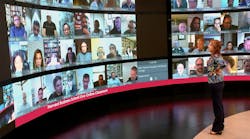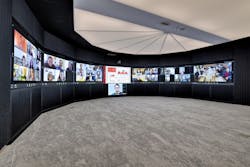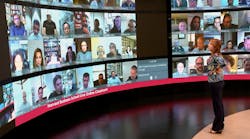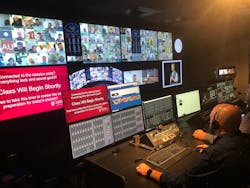While some cutting-edge universities were already developing hybrid classroom capabilities, COVID-19 forced all educational institutions to embrace remote learning technologies. But even with students largely returning to the classroom today, a strong interest in hybrid learning options remains.
A recent Anthropology/SUNESCO survey of more than 5,000 student and university leaders in 10 countries reported that 80% prefer online learning options.
“Factors that continue to drive interest in creating hybrid learning environments include non-traditional students, increased enrollment, opportunities for hosting guest lecturers from other institutions and providing access to education for students who may not be able to travel to campus due to geographic, economic or personal reasons,” said DLR Group Principal and Higher Education Design Leader Benjamin R. Strain.
While this is obviously a strong trend, many institutions are still struggling to design and technologically equip their classrooms to best create immersive learning environments for live and remote learners.
Optimizing Interiors
While technology is the major component in hybrid learning spaces, it must go hand in hand with key classroom design strategies. For interiors, Strain recommends neutral colors like greys, tans and beiges. And with painted surfaces, flat or low sheen coatings will help mitigate light reflectance that can confuse cameras, cause hot spotting or wash out projected images.
Proper lighting is essential as well. This includes adjustable, zoned lighting systems for creating the right ambiance and soft, diffused options that are camera-friendly. Lighting design should also be optimized to illuminate the instructor and classroom while avoiding glare or discomfort.
Another consideration must be the view framing the teacher and classroom, as this can provide longer focal points and social connection beyond the immediate learning space. Possibilities include windows, displays, project areas and/or an opportunity for branding.Wired Up
While there is a large sliding scale of technological capabilities with hybrid classrooms, a basic set up includes cameras, microphones, dual presentation capabilities for both in-person and remote learners, robust WiFi, high-speed bandwidth networks and proper acoustics. But if the goal is to create a more seamless environment where students really feel engaged, then a greater investment in audio and visual equipment is in order.
“To create an immersive remote learning environment during a live classroom lecture, clear audio is of paramount importance both within the room and for remote participants. Achieving this involves using a variety of professional microphones with distinct directional pickup patterns,” explained Ernie Beck, an associate principal with NV5’s Technology & Acoustics division in Washington, D.C.
If there is a budget for professional quality equipment, he recommends “beamforming” microphones, which are highly effective in capturing the voices of seated students with a high level of clarity while actively suppressing distracting background noise. This same sound quality for the instructor can be achieved with a directional handheld, lavalier or gooseneck microphone which filters out background noise and clearly projects the teacher’s voice throughout the room.
DLR Group Principal and Senior Design Leader Raymond Kent, recommends multi-point audio systems that can “tune the room” while also providing live mixing of soundscapes to capture three-dimensional sound. “A remote student can sense the location of presenters and fellow classmates while experiencing a real-world feel,” he said.
Additional strategies include acoustic panels and sound-absorbing materials for reducing echo and reverberation, and an audio mixer to balance audio levels from different sources.
Equally important to sound quality is vision. While a basic webcam will technically accomplish this, multiple cameras deployed throughout the classroom can significantly boost visual engagement.
“For instance, one camera should be focused on the instructor, providing a front-row view of their presentations, while another camera can capture the dynamics of the classroom audience, allowing remote students to feel more connected to the physical classroom,” explained Beck.
Cameras with tracking systems utilize autosense motion/sound technologies to spotlight students who are speaking. Available at a realistic price point, this technology obviates the need for camera operators.
Completing a high quality visual system are strategically positioned and sized monitors. “When a remote participant starts speaking, their window can be spotlighted on the auxiliary monitors, allowing students to identify the speaker and observe their facial queues and expressions,” explained Beck.
A common stumbling block with things like Power Point presentations is when the classroom’s main monitor fully displays the content while relegating remote participants to thumbnail views on the screen. To solve this issue, he advises introducing additional monitors displaying remote participants in strategic locations. This ensures their continuous visibility when content is being shared.
Drawing Parallels
Another case for investing in good quality hybrid learning environments is preparing students to enter the workforce “tech ready” for collaborating with colleagues, customers and clients via online platforms. Consequently, there are many parallels in design for both market sectors.
Similar to classrooms, hybrid conference rooms require high quality audio, large screens displaying remote participants, clearly visible chat screen prompts, two-way digital boards and furniture that supports added equipment, according to DLR Group Senior Principal and Global Workplace Leader Jeremy Reding.
Also key in both cases is the issue of equity. If a hybrid space lacks a good quality, well thought-out design, the remote participants will inevitably feel that their voice has been compromised.
“The minute someone that is in person gets up to write or draw on a white board that virtual attendees cannot interact with, the meeting is over for those calling in or joining remotely,” said Reding. Therefore, that extra investment in design and technology to resolve that is almost always worthwhile.
Ultimately, Beck says both sectors can benefit from the cross-pollination of ideas, strategies and best practices with audiovisual technology, purposeful space design and the user experience. “At the end of the day, designers are trying to solve for human challenges brought on by the modern world whether in education or in the workplace,” he concluded.
Next Level
While many institutions were struggling to hastily piece together remote learning capabilities once the pandemic hit, Harvard Business School (HBS) was well ahead of the game. They were already building a super high-tech online classroom for its Executive Education program that firms could look to as a prime example of the future of hybrid learning.“During each session, we carefully curate the video seen by each participant to recreate the energy of being in a HBS classroom. If a participant speaks, we bring them into view of the whole class,” explained Dustin Hilt, director of the HBS Live Online Classroom in Boston.
In addition, the set up features three digital chalkboards, robust polling features and interactive breakout rooms. “Faculty can see when participants raise their hands, when they lean into the discussion and when they’re not fully engaged,” noted Jeanne Po, managing director for HBS’ learning experience design and interactive spaces.
To deliver the ultimate virtual experience, the HBS team carefully considered and evaluated every element of the initial design. In close to 80 experiments, every aspect of their model was tested prior to construction.“The vision from the original Live Online Classroom to today has remained the same—it is to make sure that remote participants anywhere in the world can feel the same energy and engagement online that they feel in our campus classrooms,” stated Hilt.
In addition to this one-of-a-kind virtual studio, the Business School also built 33 hybrid classrooms and 42 hybrid conference rooms for faculty, staff and student use. Beyond a traditional gallery, remote participants are showcased on screens around the classroom and cameras automatically pan to students who are speaking, further enhancing these connections.
“These screens allow for a virtual speaker to be highlighted on their own screen, bringing their presence more into the room than you experience in a general virtual session,” explained Po. “It also makes it much easier for presenters to see remote participants who may have their hands up or that are expressing body language that indicates they have something to say.”
HBS also uses these spaces for more immersive staff meetings and administrative office functions.
About the Author
Barbara Horwitz-Bennett
Contributing Editor
Barbara Horwitz-Bennett has been covering the AEC industry for the past 25 years. She writes for a number of industry magazines and works with AEC firms and product manufacturers on content writing projects.





